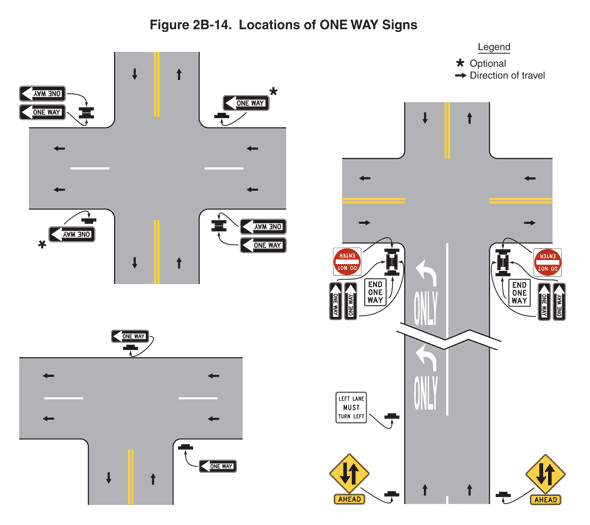2009 Edition Part 2 Figure 2B-14. Locations of ONE WAY Signs

Figure 2B-14. Locations of ONE WAY Signs
This figure shows three locations of ONE WAY signs.
Black inverted "Ts" denote signs. A legend shows an asterisk indicating optional use and a black arrow indicating the direction of travel in the lanes.
The first illustration shows an intersection of a vertical two-lane roadway with a horizontal two-lane roadway. Black arrows on the vertical roadway indicate that the direction of travel is one lane in each direction, and a solid double yellow line is shown separating the opposing direction lanes, except through the intersection. On the horizontal roadway, black arrows indicate that the direction of travel for both lanes is east to west. A broken white line separates the two westbound lanes, except through the intersection. On the vertical roadway, to the right of the northbound lane in advance of the intersection, two ONE WAY signs are shown mounted back-to-back. One is shown pointing west (to the left) and facing south, and the other is shown pointing west (to the right) and facing north. to the right of the northbound lane in advance of the intersection, a ONE WAY sign pointing west (to the right) is shown facing south. To the left of the southbound lane in advance of the intersection, a ONE WAY sign marked with an asterisk is shown pointing west (to the left) and facing north. To the right of the northbound lane on the north side of the intersection, a ONE WAY sign marked with an asterisk is shown pointing west (to the left). To the left of the southbound lane on the north side of the intersection, two ONE WAY signs are shown mounted back-to-back. One is shown pointing west (to the left) and facing south, and the other is shown pointing west (to the left) and facing north.
The second illustration shows a T-shaped intersection of a vertical two-lane roadway with a horizontal two-lane roadway. Black arrows on the vertical roadway indicate that the direction of travel is one lane in each direction, and a solid double yellow line is shown separating the opposing direction lanes, except through the intersection. Black arrows on the horizontal roadway indicate that the direction of travel is one way east to west. A broken white line separates the two lanes of the horizontal roadway. To the right of the northbound travel lane in advance of the intersection with the horizontal roadway, a ONE WAY sign is shown pointing west (to the left) and facing south. On the far side of the intersection directly opposite the vertical roadway, another ONE WAY sign pointing west (to the left) and facing south is shown to the north side of the horizontal roadway.
The third illustration shows an intersection of a segment of a vertical two-lane roadway with a horizontal two-lane roadway. Black arrows on the horizontal roadway indicate that the direction of travel is one lane in each direction, and a solid double yellow line is shown separating the opposing direction lanes, except through the intersection. Black arrows on the vertical roadway indicate that the direction of travel for both lanes is south to north in advance of the intersection, and that on the far side of the intersection, the direction of travel is one lane in each direction. In advance of the intersection, a solid white line is shown separating the two northbound lanes, and in the left lane, the pavement is shown marked with a vertical white arrow curving up and to the left over the word "ONLY" in white, followed by another closer to the intersection. At the bottom of the illustration to both the left and right of the vertical roadway, a sign assembly is shown. It is shown as a Two-Way Traffic symbol sign above a horizontal orange plaque with the word "AHEAD" in black and is facing south. To the left of the roadway opposite the first turn arrow on the pavement, a square white sign with a black border and legend is shown with the words "LEFT LANE MUST TURN LEFT." To the right of the right northbound lane in advance of the intersection, a four-piece sign assembly is shown. It is shown composed of two ONE WAY signs mounted back-to-back, one pointing north (to the left) and facing west and the other pointing north (to the right) and facing east. Mounted perpendicular and to the south side of these two signs is a vertical rectangular white sign with the words "END ONE WAY" facing south. On the north side of this sign assembly is mounted a Do Not enter sign facing north. This same sign assembly is shown to the left of the left northbound land in advance of the intersection.
